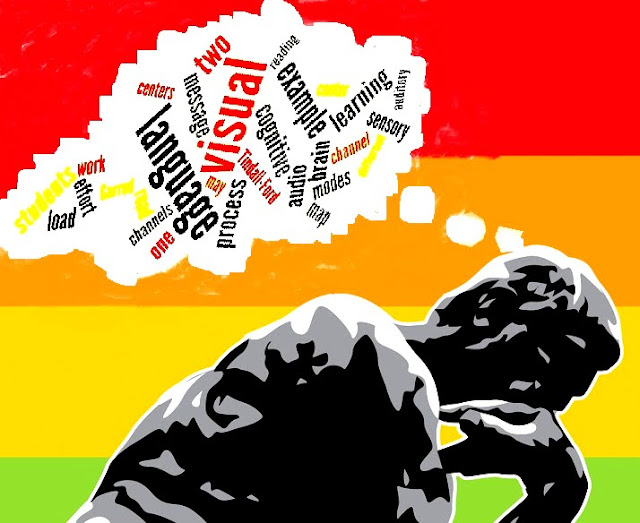|
Constructivism is an epistemological belief about what "knowing" is and how one "come to know." Contructivists believe in individual interpretations of the reality, i.e. the knower and the known are interactive and inseparable.
Constructivism rejects the notions that
- Knowledge is an identifiable entity with absolute truth value
- Meaning can be passed on to learners via symbols or transmission
- Learners can incorporate exact copies of teacher's understanding for their own use
- The whole concepts can be broken into discrete sub-skills, and that concepts can be taught out of context.
Constructivism, with focus on social nature of cognition, suggests an approach that
- Gives learners the opportunity for concrete, contextually meaningful experience through which they can search for patterns, raise their own questions, and construct their own models.
- Facilitates a community of learners to engage in activity, discourse, and reflection
- Encourages students to take on more ownership of the ideas, and to pursue autonomy, mutual reciprocity of social relations, and empowerment to be the goals.
Who are primary contributors?
Perkins (1992) pointed out the origins of the constructivism:
"Constructivism has multiple roots in psychology and philosophy of this century: the developmental perspective of Jean Piaget, the emergence of cognitive psychology under the guidance of such figures as Jerome Bruner and Ulric Neisser, the constructivist perspective of philosophers such as Nelson Goodman."
This knowledge base will discuss particular the major influence from the field of cognitive science, i.e. the work of Piaget and Bruner, as well as from the work of socio-historical psychologists, such as Vygotsky.
Piaget (Also see Cognitivism)
Piaget's theory is fundamental to cognitivism and to constructivism. His central idea is that "knowledge proceeds neither solely from the experience of objects nor from an innate programming performed in the subject but from successive constructions." (Fosnot, 1996). Piaget (1985) proposed that the mechanism of learning is the process of equilibration, in which cognitive structure assimilates and accommodates to generate new possibilities when it is disturbed based on human's self-organizing tendency.
Lev Vygotsky
Vygotsky's sociohistorical development psychology focuses on the dialectic between the individual and society, and the effect of social interaction, language, and culture on learning. To Vygosky (1978), learning is a continual movement from the current intellectual level to a higher level which more closely approximates the learner's potential. This movement occurs in the so-called "zone of proximal development" as a result of social interaction. Thus, an understanding of human thinking depends in turn on an understanding of the mechanism of social experience; the force of the cognitive process deriving from the social interaction is emphasized. Also, the role of the adult and the learners' peers as they conversed, questioned, explained, and negotiated meaning is emphasized.
Vygostky's Sociohistorical Learning Theory or Sociocultural theory
Vygotsky was disappointed with the overwhelming control of environment over human behavior that is represented in behaviorism. Vygotsky (1978) objected to any tendency to equate human beings with animals on the basis of innate reflexes and conditional reflexes. He recognized the higher psychological functions of humans, especially the distinguishing mental process of signification by which humans assign meanings to arbitrary stimuli and with which human learning is determined by the social and historical context. He believed that human development and learning occur through their interactions with the environment and the other people in it.
Three themes that form the core of Vygotsky's theoretical framework: (Wertsch, 1992)
- A reliance on a genetic or developmental method:
Vygotsky (1978) recognized two basic processes operating continuously at every level of human activity: internalization and externalization. Vygotsky proposed that even though every complex mental function is first an interaction between people, it subsequently becomes a process within individuals. It is the transition from the external operation to internal development which undergoes qualitative changes. This transformation involves the mastery of external means of thinking and learning to use symbols to control and regulate one's thinking.
- The claim that higher mental processes in the individual have their origin in social processes.
-
The concept of Zone of Proximal Development: to Vygosky, learning is a continual movement from the current intellectual level to a higher level which more closely approximates the learner's potential. This movement occurs in the so-called "zone of proximal development" as a result of social interaction. The zone of proximal development is the distance between the actual independent development level and the potential development level under the guidance of or in collaboration with peers (Vygotsky, 1978). Vygotsky believes that human mental activity is a particular case of social experience. Thus, an understanding of human thinking depends in turn on an understanding of the mechanism of social experience; the force of the cognitive process deriving from the social interaction is emphasized.
- Mediation: the claim is that mental processes can be understood only if we understand the tools and signs that mediate them. Changing a stimulus situation in the process of responding to it establish mediation, e.g. the gesture of pointing could not have been established as a sign without the reaction of the other person. This also implies that any higher mental function necessarily goes through an external stage in its development because it is initially a social function.
Implications to learning and instruction:
- Learning in authentic context: The conception of mediation gives the emphasis to the interaction between individuals and the historical and cultural development. Situate learners in an authentic context, in which learners construct via dialectical relations among people acting, the contexts of their activity, and the activity itself.
-
Providing Scaffolding: Learning takes place in the social interaction with older, more learned members of the society: learning occurs when individual is prompted to move past current levels of performance and develop new abilities. Thus, provide external support from the instructor, peers, experts, artifacts or tools as the learners construct knowledge.
Bruner
A major theme of Bruner's construction theory is that learning is an active process in which learners construct new ideas or concepts based upon their current/past knowledge. The learner selects and transforms information, constructs hypotheses, and makes decisions, relying on a cognitive structure, e.g. schema and mental models, to do so. The interconnection of the new experience with the prior knowledge results in the reorganization of the cognitive structure, which creates meaning and allows the individual to "go beyond the information given".
According to TIP's (Theory Into Practice database) abstract of Bruner's theory, the principles of instruction based on Bruner include:
- Readiness: Instruction must be concerned with the experiences and contexts that make the student willing and able to learn
- Spiral organization: Instruction must be structured so that it can be easily grasped by the student
- Going beyond the information given: Instruction should be designed to facilitate extrapolation and or fill in the gaps
Bruner's Constructive Learning
Bruner (1986) claims that constructivism began with Kant's concepts of a priori knowledge, which focuses on the importance of prior knowledge (what we know) to what we perceive from out interactions with the environment. Jonassen (1991) described Kant's ideas of individual construction of reality: " Kant believed in the external, physical world (noumena), but we know it only through our sensation (phenomena) - how the world appears to us."
TIP (Theory Into Practice database) described that Bruner's major theoretical framework is that learning is an active process in which learners construct new ideas or concepts based upon their current/past knowledge. In other words, Learning is an active, social process in which students construct new ideas or concepts based on current knowledge. The student selects information, originates hypotheses, and makes decisions in the process of integrating experiences into their existing mental constructs.
What are Bruner's key concepts? (Driscoll, 2000)
Three Modes of presenting understanding
- Enactive representation, a mode of representing past events through appropriate motor responses
- Iconic representation, which enables the perceiver to "summarize events by organization of percepts and of images
- Symbolic representation, "a symbol system which represents things by design features that can be arbitrary and remote, e.g. language
- Different from a fixed sequence of developmental stages, Bruner emphasizes the influences from the environment on amplification of the internal capabilities that learners possess.
|
Bruner's readiness
|
Piaget's readiness
|
Ausubel's readiness
|
| Readiness of the subject matter for the learner: how to match instruction to the child's dominant mode of thinking |
Cognitive readiness of the learner to understand the logical operations in a subject matter |
Appropriateness in terms of the child's prior knowledge, i.e. what she knows and how she structure that knowledge in memory |
Different from Piaget's cognitive development, which proposed that the qualitative difference in thinking is a stage-like development, Bruner's concept is that whereas symbolic representation is likely to be used for learning something new in a familiar topic; learners of all ages may resort to enactive or iconic representation when they encounter unfamiliar materials. Thus, to determine what mode of representation will be optimal for instruction requires knowing something about the learner's prior knowledge and dominant modes of thinking.
- Schooling as an instrument of culture. Knowing is a process, not a product. Children should be accepted as members and participants in the culture and provide opportunities to make and remake the culture in each generation.
Bruner (1966) states that a theory of instruction should address four major aspects:
- Predisposition towards learning
- The ways in which a body of knowledge can be structured so that it can be most readily grasped by the learner
- The most effective sequences in which to present material
- The nature and pacing of rewards and punishments..
Bruner's influence on instruction
- Spiral Curriculum: Translating material into children's modes of thought: presenting topics consistent with children's forms of thought at an early age and then reintroducing those topics again later in a different form
- Interpersonal interaction is a means that enable learners to develop cognitive growth: questioning, prompting
- Discovery learning: discovery as" all forms of obtaining knowledge for oneself by the use of one's own mind"
Students need to determine what variables are relevant, what information should be sought about those variables, and when the information is obtained, what should be done with it.
Discovery of a concept proceeds from a systematic comparison of instances for what distinguishes examples from non-examples. To promote concept discovery, the teacher presents the set of instances that will best help learners to develop an appropriate model of the concept.
Contrast that lead to cognitive conflicts can set the stage for discovery
-
Variables in instruction: nature of knowledge, nature of the knower, and nature of the knowledge-getting process
-
Promote discovery in the exercise of problem solving
-
Feedback must be provided in a mode that is both meaningful and within the information-processing capacity of the learner.
-
Intrinsic pleasure of discovery promote a sense of self-reward
Von Glasersfeld
Von Glasersfeld development of the epistemological basis of the psychological variant incorporates both the Piagetian notion of assimilation and accommodation and the cybernetic concept of viability (Cobb, 1994). The value of knowledge no longer lies in its conveyance of truth, but its viability in individual experience.
Von Glasersfeld (1992) stated that "Truths are replaced by viable models, and viability is always relative to a chosen goal."
Similar to Piaget, von Glasersfeld sees learning as an active process of self-organization in which the individual eliminate 'perturbation' (disequlibrium in Piaget's term) from the interaction with others as well as an active construction of viable knowledge adapted from the interaction with others.
Individuals' construction of their ways of knowing is the focus of von Glaserfeld. But, he also recognizes the importance of social interaction as a process of meaning negotiation in this subjective construction of knowing.
What does it mean to learning?
Constructivism, applied as an explanatory framework of learning, describes how the learner constructs knowledge from experience, which makes it unique to each individual.
Points of view of constructivism bring forth two major trends of explaining how leaning occurs:
- cognitive constructivists, focusing on the individual cognitive construction of mental structures
- sociocultural constructivists, emphasizing the social interaction and cultural practice on the construction of knowledge.
Both trends believe that:
- Knowledge cannot exist independently from the knower; knowledge cannot be reproduced and transmitted to another person.
- Learning is viewed as self-regulatory process:
- Cognitive constructivists focus on the active mental construction struggling with the conflict between existing personal models of the world, and incoming information in the environment.
- Sociocultural constructivists emphasis the process of enculturation into a community of practice, in which learners construct their models of reality as a meaning-making undertaking with culturally developed tools and symbols (Vygotsky, 1978), and negotiate such meaning thorough cooperative social activity, discourse and debate (Von Glaserfeld, 1992)
- Learners are active in making sense of things instead of responding to stimuli. Unlike information processor taking in and storing up information, learners " make tentative interpretations of experience and go on to elaborate and test those interpretations"(Perkins, 1992)
Impacts on Instructional Design
Constructivism provides different views of learning. Learners are no longer passive recipients and reproducers of information.
Learners are active constructors of their own conceptual understanding, and active meaning makers interacting with the physical and social world.
The design of learning environment based on constructivist view of learning emphasizes the integration of three types of human experiences (Vygotsky, 1978):
- historical experience, e.g. the traditions and practices of a culture
- social experience
- adaptation experience, in which people engage in active adaptation, changing the environment.
Below are some general principles of learning derived form constructivism (Smith and Ragan, 2000; Driscoll, 2001; Duffy & Jonassen, 1992):
- Learning requires invention and self-organization on the part of learners
- Disequilibrium facilitates learning: Errors need to be perceived as a result of learners' conceptions and therefore not minimized or avoided. Thus, challenge students with open-ended investigations in realistic, meaningful contexts need to be offered; allow learners to explore and generate many possibilities, both affirming and contradictory.
- Reflective abstraction is the driving force of learning: As meaning-makers, humans seek to organize and generalize across experiences in a representational form
- Dialogue within a community engenders further thinking: the learners are responsible for defending, proving, justifying, and communicating their ideas to the classroom community.
Principles of designing learning environment
Jonassen (1996) proposed that learning environments should provide active, intentional, complex, contextualized, reflective, conversational, collaborative, and constructive learning.

Image from David Jonassen's site
Driscoll (2000) listed constructivist principles for designing learning:
- Embed learning in complex, realistic and relevant environments
- Provide a social negotiation as an integral part of learning
- Support multiple perspectives and the use of multiple modes of representation
- Encourage ownership in learning
- Nurture self-awareness of the knowledge construction process
About design of instruction
Based on Jonassen (1992) and Driscoll (2000), constructivism has the following impacts on instructional design:
- Instructional goals and objectives would be negotiated not imposed
- Task analysis would concentrate more on considering appropriate interpretations and providing the intellectual tools that are necessary for helping learners to construct knowledge
- Designers would provide generative, mental construction tool kits embedded in relevant learning environments that facilitate knowledge construction by learners
- About evaluation:
Since constructivism does not hold the that the function of instruction is to transmit knowledge that mirrors the reality and its structures to the learner's mind, criterion-referenced evaluation, which is based on predetermined objective standards, is not an appropriate evaluation tool to constructivistic environments (Jonassen, 1992). The focus of evaluation should be placed on the process of knowledge construction rather than the end products of learning. And even if the end results are evaluated, it should emphasize the higher order thinking of human being.
- The evaluation of learning focus on the higher order thinking, the knowledge construction process, and the building of the awareness of such process.
- The context of evaluation should be embedded in the authentic tasks and meaningful real-world context.
- The criteria of evaluation should represent multiple perspectives in learning environment. From the perspective of socio-cultural constructivist, since "no objective reality is uniformly interpretable by all learners, then assessing the acquisition of such reality is not possible" (Jonassen, 1992). Thus, the evaluation should focus on the learning process rather than the product.
- Portfolio evaluation: different student interpretation at different stages in their learning process. Learning is multifaceted and multiperspectival, so as the results of learning.
- The function of evaluation is not in the reinforcement or behavior control tool but more of "a self-analysis and metacognitive tool".
References:
Bruner, J. (1986). Actual Minds, Possible Worlds. Cambridge, MA: Harvard University Press.
Driscoll, M. P. (2000). Psychology of learning for instruction. 2nd ed. Needham Heights, MA: Allyn & Bacon.
Cobb, P. (1994). Where is the Mind? Constructivist and sociocultural perspectives on mathematic development. Educational Researcher, 23 (7), pp. 13-20
Fosnot, C. T. (1996). (Ed.) Constructivism: Theory, perspectives, and practice. New York, NY: Teachers College Press.
Jonassen, D. H. (1992). Evaluating constructivist learning. In T. M. Duffy, & D. H. Jonassen (eds), Constructivism and the technology of instruction: A conversation. Hillsdale, NJ: Lawrence Erlbaum Association.
Piaget, J. (1985). The equilibration of cognitive structures. Chicago, IL: University of Chicago Press.
Smith, P. L., & Ragan, T. J. (1999). Instructional Design. 2nd ed. New York, NY: John Wiley & Sons, Inc.
Von Glaserfeld (1992). Constructivism reconstruction: A reply to Suchting. Science and Education, 1, 379-384.
Vyogtsky, L. S. (1979). Consciousness as a problem in the psychology of behavior.Soviet Psychology, 17 (4), 3-35. (Original work published in 19-24).
Vygotsky, L. S. (1978). Mind in society: The development of higher psychology process. Cambridge, MA: Harvard University Press. (Original published in 1930).
Wertsch, J. V. (1992). L. S. Vygotsky and contemporary developmental psychology. Developmental Psychology, 28 *4), 548-557. Vygotsky, L. (1986). Thought and language. Cambridge, MA: MIT Press. (Original work published 1962).
|
like cassoulet.









